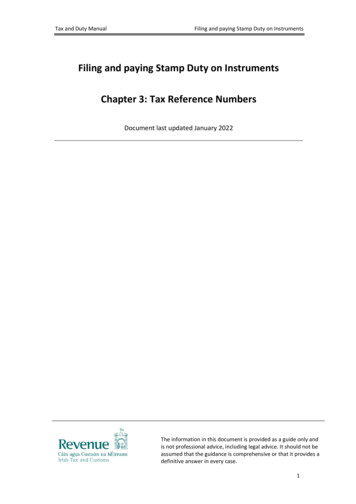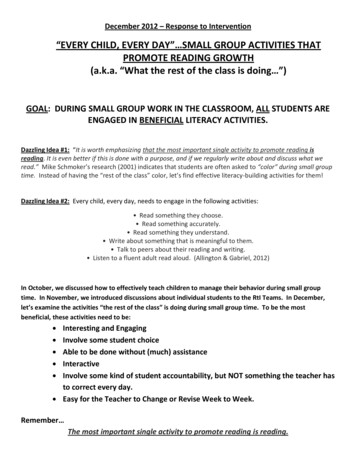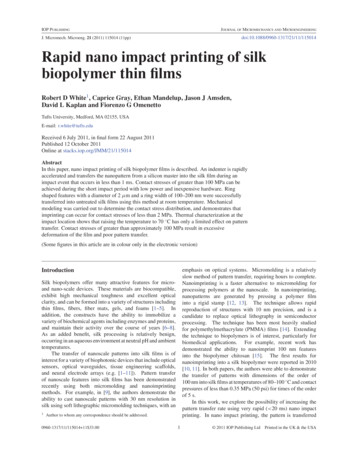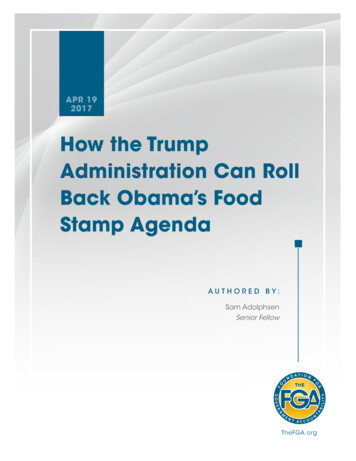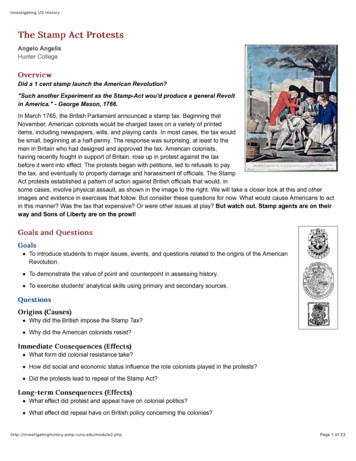
Transcription
Investigating US HistoryThe Stamp Act ProtestsAngelo AngelisHunter CollegeOverviewDid a 1 cent stamp launch the American Revolution?"Such another Experiment as the Stamp-Act wou'd produce a general Revoltin America." - George Mason, 1766.In March 1765, the British Parliament announced a stamp tax. Beginning thatNovember, American colonists would be charged taxes on a variety of printeditems, including newspapers, wills, and playing cards. In most cases, the tax wouldbe small, beginning at a half-penny. The response was surprising, at least to themen in Britain who had designed and approved the tax. American colonists,having recently fought in support of Britain, rose up in protest against the taxbefore it went into effect. The protests began with petitions, led to refusals to paythe tax, and eventually to property damage and harassment of officials. The StampAct protests established a pattern of action against British officials that would, insome cases, involve physical assault, as shown in the image to the right. We will take a closer look at this and otherimages and evidence in exercises that follow. But consider these questions for now. What would cause Americans to actin this manner? Was the tax that expensive? Or were other issues at play? But watch out. Stamp agents are on theirway and Sons of Liberty are on the prowl!Goals and QuestionsGoalsTo introduce students to major issues, events, and questions related to the origins of the AmericanRevolution.To demonstrate the value of point and counterpoint in assessing history.To exercise students' analytical skills using primary and secondary sources.QuestionsOrigins (Causes)Why did the British impose the Stamp Tax?Why did the American colonists resist?Immediate Consequences (Effects)What form did colonial resistance take?How did social and economic status influence the role colonists played in the protests?Did the protests lead to repeal of the Stamp Act?Long-term Consequences (Effects)What effect did protest and appeal have on colonial politics?What effect did repeal have on British policy concerning the /module2.phpPage 1 of 23
Investigating US HistoryBackground readingIn what context did the Stamp Act emerge?Tensions between Great Britain and its American colonies emerged at a moment when the colonies were still celebratingthe British victory against France. The colonies contributed much to the victory by sending militia, providing supplies andhousing British troops during the French and Indian War —the American phase of a larger, transatlantic conflict. Thewar ended in 1763, leaving Britain with a staggering debt and with an increased empire that demanded more and closeradministration.Where could British officials look for revenue? Taxes were already high in Britain. But they had not been collected to anygreat extent in the colonies. Taxes based on trade between the British American colonies and British and foreign marketsand suppliers presented one solution. Regulations on trade between the colonies and British and non-British merchantswere already in place prior to 1763. These regulations aimed at protecting and increasing business opportunities forBritish merchants and at curtailing illegal trade or smuggling on the part of colonial merchants. They did not aim atcollecting revenue.But the British ministry failed for an extended period to fully enforce even these regulations. This failure can be viewed aspart of a larger policy that historians refer to as benign (or salutary) neglect —a somewhat lax enforcement of imperialrule. Customs officials were responsible for enforcing the trade regulations. But they were often underpaid, overworkedand had to fulfill their duties without legal or physical support. Some accepted bribes to look the other way whenimporters and ship masters violated import restrictions or failed to declare goods in order to avoid the payment of taxes.The practice of benign neglect had also established an understanding of home rule in the colonies that gave the majorityof authority for domestic governance (government and administration within the colonies) to the colonial legislatures.Thus, the colonies accepted the authority of the British Parliament in imperial matters, although many colonialmerchants and shipmasters worked to avoid the trade regulations imposed by Parliament. The British and BritishAmerican perspectives were in conflict and they had already created tensions prior to the Stamp Act.In 1760-1761, the colonies challenged attempts on the part of British official to use of writs of assistance, which hadbeen recently authorized by the Parliament, to locate and seize smuggled goods. The writs were similar to modern-daysearch warrants, but they did not require evidence of wrongdoing or judicial approval. The colonists argued that the writsviolated English constitutional protections against search and seizure of private and business property.A second conflict emerged in 1764 over the Sugar Act. The act taxed all sugar and molasses imported from the FrenchWest Indies. The act also restricted exports of certain raw materials from the colonies by requiring that they go throughBritish merchants. The Sugar Act aimed, in part, at improving import opportunities for British merchants by discouragingpurchases from and sales to non-British suppliers. The Sugar Act would also raise revenue for use in supporting Britishtroops in North America. Thus, the Sugar Act would hurt colonial merchants, shipmasters, anyone involved in themaritime trades and many consumers.The colonists reacted with anger to the Sugar Act, not only because of the money involved and the complicatedprocedures it imposed, but also because the act violated certain fundamental principals of freedom, as they wereunderstood in the British American colonies. First, the Sugar Act challenged the right to a local trial by a jury of one'speers by allowing customs officials to try smugglers in vice-admiralty courts. Defendants face a single justice, whowould be a British appointed and paid official, without the benefit of a jury. Second, the Sugar Act violated a long-standingprecedent in which Britain had not taxed the colonies to raise revenue. Now the colonies faced an indirect tax, a taxadded to the cost of the goods, rather than a direct tax that would require payment from the consumers. This would set anew precedent. How far would the British Parliament go in taxing the colonists, if they allowed the Sugar Act to stand?The Stamp Act answered the question in negative terms for many of the colonists.What options were left to the colonies, if they wanted to resist taxes and their enforcement? The colonists issuedpetitions to the governor and to British officials and published pamphlets for the public that outlined the reasons e2.phpPage 2 of 23
Investigating US Historyprotesting the taxes. Merchants continued to smuggle taxable goods and, in some cases, increased the amount of illegalimports. Political leaders called on consumers to boycott taxed items by refusing to buy or consume them. Politicalleaders could also call on crowds to enforce boycotts by preventing the landing of goods or by harassing officials.Were these crowds legal? In some ways, the crowds violated British riot laws. But crowds were also a long-standingEnglish tradition and had been tolerated as long as they kept their actions within limits and aimed at specific goals.Political leaders from the highest ranks of society often acted as sponsors for the crowds. Middle-level citizens—artisansor craftsmen and merchants—provided the organization and leadership. But crowds could and often did get out of handonce they were underway. The property damage and physical violence that accompanied some crowd actions worriedinfluential colonists on both sides of the political debate. Yet, the crowds were vital to the success of the resistanceagainst British authority. They served as an important tool for recruiting ordinary citizens. Many of the men whoparticipated in the crowd actions would also serve in the militia and the Continental Army during the American Revolution.Equally important was the impetus crowd actions added to the dissemination and popularization of political ideas.Arguments against the taxes, particularly the early arguments made by James Otis, Jr., established the concept thattaxes could not be constitutionally imposed by any political body that was not elected by the people (“no taxation withoutrepresentation”). The constitutional critique of British tax policy expanded over the next few years to include a defense ofthe colonial charter and of English constitutional rights. These ideological debates combined with boycotts and crowdactions to provoke an aggressive response from British officials, particularly from the colonial governors, whose authoritywas most directly challenged.Colonial governors assumed aggressive positions in defense of royal authority, locking horns with patriot leaders in thelegislature. The British ministry dispatched troops to the colonies to support the governors and the collection of taxes andenforcement of trade regulations. The presence of British troops added to the growing anger of the colonists and a seriesof increasingly violent events. And the colonies found common ground in the protests against the taxes and in theirresponse to British odule2.phpPage 3 of 23
Investigating US HistoryActivitiesActivity 1: Why the Stamp Act? And why all the fuss?INVESTIGATING THE ORIGINSInterrogating the EvidenceHistorians begin with a question or set of questions. They use these questions toexamine evidence or sources in order to develop and support their arguments.This exercise asks you to examine a group of sources against a series ofquestions given below. Be sure that you create a set of reading notes for yourresponses. You will need them later in this module.Read these notes before you read the Act:1. The text below is highly condensed and extracted. The original Stamp Actwould take up 21 typewritten pages, single spaced and in the standard print.2. Vellum and parchment are expensive printing materials made from animalskins (sheep, lamb, or calf). They were more lasting then ordinary paper andwere generally used for important documents, like royal proclamations andcollege diplomas. This is why college diplomas are often referred to as“sheepskins,” even though they are no longer printed on this material.For an original copy of the text of the StampAct and a complete transcript from theNATIONAL ARCHIVES websiteThe Stamp Act [condensed]In Parliament March 19, 1765An act for granting and applying certain stamp duties, and other duties, in the British colonies and plantations in America,towards further defraying the expences of defending, protecting, and securing the same; and for amending such parts ofthe several acts of parliament relating to the trade and revenues of the said colonies and plantations, as direct themanner of determining and recovering the penalties and forfeitures therein mentioned.For every skin or piece of vellum or parchment, or sheet or piece of paper, on which shall be ingrossed, written or printed,any declaration, plea, replication, rejoinder, demurrer, or other pleading, or any copy thereof, in any court of law within theBritish colonies and plantations in America. any special bail and appearance upon such. any petition, bill, answer, claim, plea, replication, rejoinder, demurrer, or other pleading in any court of chancery orequity [civil court].For every skin or piece of vellum or parchment, or sheet or piece of paper, on which shall. any libel, answer, allegation, inventory, or renunciation in ecclesiastical matters in any court of probate, court of theordinary. any copy of any will (other than the probate thereof). any register, entry, testimonial, or certificate of any degree taken in any university, academy, college, or seminary oflearning.any pleading, in any admiralty court [courts regulating trade]. any writ of covenant for levying of fines. any judgment, decree, sentence, or dismission, or any record of Nisi Prius or Postea, in any court within the saidcolonies and plantations, a stamp duty of four shillings. any affidavit, common bail or appearance, interrogatory deposition, rule, order, or warrant of any court. any licence, appointment, or admission of any counsellor, solicitor, attorney, advocate, or proctor, to practice in anycourt, or of any notary. any note or bill of lading [shipping manifest], which shall be signed for any kind of goods, wares, or merchandize, to 2.phpPage 4 of 23
Investigating US Historyexported. any grant, appointment, or admission of or to any publick beneficial office or (except commissions and appointments ofofficers of the army, navy, ordnance, or militia, of judges, and of justices of the peace). any licence for retailing of spirituous liquors. any licence for retailing wine. any probate of a will, letters of administration, or of guardianship for any estate above the value of twenty poundssterling money. any bond for securing the payment of any sum of money [a sliding scale based on the amount of money]. any deed or other instrument whatsoever, by which any quantity of land be granted, conveyed, or assigned [a slidingscale based on the size of the parcel]. any indenture [labor contract], lease, conveyance, contract, stipulation, bill of sale, charter party, protest, articles ofapprenticeship, or covenant. any passport, or let-pass, surrender of officer, or policy of assurance. any notarial act, bond, deed, letter, of attorney, procuration, mortgage, release, or other obligatory instrument. every pack of playing cards, and all dice. any pamphlet, and upon every news paper, containing publick news, intelligence, or occurrences, which shall beprinted, dispersed, and made publick, within any of the said colonies and plantations. every advertisement to be contained in any gazette, news paper, or other paper, or any pamphlet. every almanack or calendar. every deed, instrument, note, memorandum, letter, or other instrument or writing, for or relating to the payment of anysum of money, or for making any valuable consideration for or upon the loss of any ship, vessel, goods, wages, money,effects, or upon any loss by fire, or for any other loss whatsoever. every deed, instrument, note, memorandum, letter, or other minument or writing, between the captain or master orowner of any ship or vessel, and any merchant, trader, or other person, in respect to the freight or conveyance of anymoney, goods, wares, merchandizes, or effects, laden or to be laden on board of any such ship or odule2.phpPage 5 of 23
Investigating US HistoryRead the short biographies of the “colonists”The following biographies reflect a mix of actual individuals and composite characters who are representative onesegment of colonial society. Biographies of actual individuals include corresponding birth and death dates. Read the shortbiography as presented and then click (where available) and read the longer biography.James Otis Jr. (1725-1783)Graduate of Harvard College and noted lawyer from a prominent landowning and mercantile family.Had resigned his position in 1761 as advocate-general (attorney general) for Massachusetts to argueagainst writs of assistance (general search warrants that gave customs officials broad power to enterand search business and private spaces.John Hancock (1737-1793)Graduate of Harvard College, ambitious merchant, and ship owner, Hancock was one of the wealthiestmen in the American colonies. Had visited England as a young man on a business mission under thesponsorship of his uncle, whose wealth he inherited. Hancock was also a leading member of thecolonial assembly, where he joined forces with the “country” faction; that is with the faction that tendedto oppose the governor.Thomas Hutchinson htmlBorn in Boston to a prosperous mercantile family with firm connections to English merchants.Graduated from Harvard and devoted most of his energies to government service. Was appointed togovernor's council in 1749. By 1760, he was the Chief Justice and Lieutenant Governor ofMassachusetts and the leading representative of the governor's or “court” faction in the legislature.Thomas Printer (Composite)One of a number of men who operated printing presses in Boston (and the other colonial cities),producing newspapers, pamphlets, advertisements, books, and a variety of other printed matter.Among the most coveted assignments was that of official printer for the colonial government. Thisequated to a steady income. But the assignment was generally granted to one specific printer, whohad some connection with the colonial administration. Printers were artisans (craftsmen), but theywere also well versed in local politics and business, which provided them with a significant amount ofinformation business and information.Paul Revere (1734 -1818)https://www.paulreverehouse.org/bio/Revere was a noted artisan who worked in one of the more prestigious crafts—silversmith. Hisproduced luxuries for the wealthiest segment of Boston. Accordingly, he competed against importsfrom Britain and his business suffered when the economy was weak. Revere supplemented hisincome by engraving copper plates that were used to print illustrations for books and a variety of otherpublished materials. He was aided in his work by assistants in the form of apprentices y.edu/module2.phpPage 6 of 23
Investigating US HistoryJack Tar (Composite)The term Jack Tar was used collectively to describe sailors in the eighteenth century. The term mayoriginate from the use of tar to waterproof sailors' hats and clothing. Sailors in this period werepositioned at the bottom of colonial society. They were rough men who earned a meager living in adangerous trade. But they were also the most mobile and traveled segment of colonial society. Theirlivelihood, like that of other maritime laborers (shipbuilders, rope makers) depended on a vigorouseconomy that made steady use of shipping.Samuel Adams gners/adams s.htmHarvard graduate with a variety of interests in business, Adams was noted for his religious intensity(Congregational) and for his active participation in local and colonial politics. Adams was regularlyelected to the town meeting and colonial assembly, with strong support from ordinary voters. He wasalso noted for aggressive, florid editorials that appeared frequently in the Boston newspapers.George Twelve Hewes (1742-1840)Poor Boston shoemaker's apprentice who worked on the wharf near John Hancock's warehouse andplace of business. Little is known about Hewes's life before the mid-1770s, but it most likely paralleledthe lives of most of Boston's apprentices and laborers. The work was hard and the hours long.Whatever free time and spending money he might have might used to “buy” a place at the local tavern,where for the price of a beer or hard cider he could converse, play cards, or possibly hear the latestnews read out loud from the latest copy of the local newspaper.Read Benjamin Franklin's testimony before Parliament at:http://www.digitalhistory.uh.edu/disp textbook.cfm?smtID 3&psid 152Pose the Following QuestionsWhat was Parliament's stated purpose for the tax, as it appears in the introduction of the Stamp Act?How did Parliament's position compare with Benjamin Franklin's testimony?Which colonists would be most opposed to the tax and which taxable item would most likely effect their decision?Writing ExerciseUse the discussion board for your response.Historians share their ideas with each other in a way that allows for a free exchange of interpretations. This exercise asksyou to do this with your classmates using the discussion board assigned by your instructor.Pick one of the colonists and post a brief comment that explains why that particular colonist would be likely tooppose the stamp tax.Comment on at least two other postings that include colonists other than the one you chose.Respond to at least two of the comments made about your original module2.phpPage 7 of 23
Investigating US HistoryOptional Secondary Exercise for in-class debateAs assigned by the instructor.Read the biography of Thomas Dawes. Consider the following question: How would Dawes have reacted to crowdactions protesting the Stamp Act in 1765 and to a similar crowd action in 1788?Thomas Dawes (1731-1809)Portrait by Gilbert Stuart, c. 1806Thomas Dawes was born in Boston, where he received a basic, but relatively undistinguishededucation. He was trained and worked as a mason, a well-respected craft in the colonial period.Dawes became involved in patriot politics in the early stages of the American Revolution. Hisconnection to other craftsmen and ordinary laborers made him a valuable organizer for crowd actions.Dawes also became friendly with some of the leading patriot leaders (Samuel Adams, John Hancockand Joseph Warren) when he allowed them to use his small living space (a garret) for their secret meetings. Hisconnection to the patriot leaders marked him as a conspirator and his home suffered damage during the Britishoccupation of Boston.Dawe's early and ardent involvement in patriot politics gave a significant boost to his political and economic careers. Hesecured a commission as a colonel in the Massachusetts militia, serving in that capacity during the American Revolution.Commissions at this level were granted by the state government and were usually given by members of the social elite.The town of Boston elected him in 1779 to serve at the convention that drafted and enacted the Massachusetts stateconstitution. Other members of the Boston delegation included Samuel Adams, John Adams and John Hancock. Dawesserved several terms in the Massachusetts House of Representatives and the Senate and was appointed in 1792 to theState Supreme Court (without benefit of legal training).By 1788, Dawes had expanded his business to include development of property and homebuilding. In effect, Dawes hadgrown from a mason or builder of brick structures into an architect. His structures include two of the most important 18thcentury structures in Boston: the Old State House and the Brattle Street Church. Increasingly wealthy, Dawes built aspacious home next to the Boston home occupied by John Adams and he was one of a few men in Boston who owned aprivate carriage or coach. His political and economic prominence led to a number of honors. Dawes was inducted as amember of the Academy of Arts and Sciences, became a close associate of John Hancock and succeeded in placing hisson, Thomas Jr., at Harvard, a privilege usually reserved at the time for men from prominent families. The portrait byGilbert Stuart testifies to his success. Stuart, who was one of the most prominent American painters of the early 19thcentury, is well known for his portraits of George du/module2.phpPage 8 of 23
Investigating US HistoryActivity 2: What form did colonial resistance take?INVESTIGATING THE PROTESTSInterrogating the evidenceHistorians draw their evidence from a variety of sources, including documents,vital records (such as birth certificates), images and artifacts (things people makeand use). This exercise asks you to draw on a combination of documentary andvisual evidence. Examine the evidence against the suggest questions and makenotes for later use.The protest in ideas and wordsRead two of the following documents. Which specific words, phrases, or ideasappear particularly important or useful in communicating an idea? Who was theaudience for the documents you selected.William Bradford, Stamp Act irginia Stamp Act elated/vsa65.htm)Resolutions of the Stamp Act ber-19-1765.php)Connecticut Resolutions on the Stamp Act(http://avalon.law.yale.edu/18th century/ct resolutions 1765.asp)George GrenvilleFirst Lord of the Treasury and laterPrime Minister"Mr. Grenville strongly urg'd not only the powerbut the right of Parliament to tax the colonys,and hop'd in Gods Name. that none woulddare dispute their Sovereignty."- Edward MonatagueThe protest in actionRead two of the following reports of the protests. How did protests work? Who attended? Who or what was targeted?What was done?1. Thomas Hutchinson Recounts the Mob Reaction to the Stamp Act in Boston,1765The distributor of stamps for the colony of Connecticut arrived in Boston from London; and, havingbeen agent for that colony, and in other respects of a very reputable character, received from manygentlemen of the town such civilities as were due to him. When he set out for Connecticut, Mr.Oliver, the distributor for Massachusetts Bay, accompanied him out of town.This occasioned murmuring among the people, and an inflammatory piece in the next BostonGazette. A few days after, early in the morning, a stuffed image was hung upon a tree, called thegreat tree of the south part of Boston [subsequently called Liberty Tree]. Labels affixed denoted it tobe designed for the distributor of stamps.Before night, the image was taken down, and carried through the townhouse, in the chamber whereof the governor andcouncil were sitting. Forty or fifty tradesmen, decently dressed, preceded; and some thousands of the mob followed downKing street to Oliver's dock, near which Mr. Oliver had lately erected a building, which, it was conjectured, he designed fora stamp office. This was laid flat to the ground in a few minutes. From thence the mob proceeded for Fort Hill, but Mr.Oliver's house being in the way, they endeavored to force themselves into it, and being opposed, broke the windows,beat down the doors, entered, and destroyed part of his furniture, and continued in riot until midnight, before y.edu/module2.phpPage 9 of 23
Investigating US HistorySeveral of the council gave it as their opinion, Mr. Oliver being present, that the people, not only of the town of Boston,but of the country in general, would never submit to the execution of the stamp act, let the consequence of an oppositionto it be what it would. It was also reported, that the people of Connecticut had threatened to hang their distributor on thefirst tree after he entered the colony; and that, to avoid it, he had turned aside to Rhode-Island. Despairing of protection,and finding his family in terror and great distress, Mr. Oliver came to a sudden resolution to resign his office beforeanother night.The next evening, the mob surrounded the house of the lieutenant-governor and chief justice [Hutchinson]. He was at Mr.Oliver's house when it was assaulted, and had excited the sheriff, and the colonel of the regiment, to attempt to suppressthe mob. A report was soon spread, that he was a favourer of the stamp act, and had encouraged it by letters to theministry. Upon notice of the approach of the people, he caused the doors and windows to be barred; and remained in thehouse.Certain depositions had been taken, many months before these transactions, by order of the governor, concerning theillicit trade carrying on; and one of them, made by the judge of the admiralty, at the special desire of the governor, hadbeen sworn to before the lieutenant-governor, as chief justice. They had been shewn, at one of the offices in England, toa person who arrived in Boston just at this time, and he had acquainted several merchants, whose names were in someof the depositions as smugglers, with the contents. This brought, though without reason, the resentment of the merchantsagainst the persons who, by their office, were obliged to administer the oaths, as well as against the officers of thecustoms and admiralty, who had made the depositions; and the leaders of the mob contrived a riot, which, after somesmall efforts against such officers, was to spend its principal force upon the lieutenant-governor. And, in the evening ofthe 26th of August, such a mob was collected in King street, drawn there by a bonfire, and well supplied with strong drink.After some annoyance to the house of the registrar of the admiralty, and somewhat greater to that of the comptroller ofthe customs, whose cellars they plundered of the wine and spirits in them, they came, with intoxicated rage upon thehouse of the lieutenant-governor. The doors were immediately split to pieces with broad axes, and a way made there,and at the windows, for the entry of the mob; which poured in, and filled, in an instant, every room in the house.The lieutenant-governor had very short notice of the approach of the mob. He directed his children, and the rest of hisfamily, to leave the house immediately, determining to keep possession himself. His eldest daughter, after going a littleway from the house, returned, and refused to quit it, unless her father would do the like. This caused him to depart fromhis resolutions, a few minutes before the mob entered. They continued their possessions until day light; destroyed,carried away, or cast into the street, every thing that was in the house; demolished every part of it, except the walls, as faras lay in their power; and had begun to break away from the brickwork. The damage was estimated at about twenty-fivehundred pounds sterling, without any regard
How did social and economic status influence the role colonists played in the protests? Did the protests lead to repeal of the Stamp Act? Long-term Consequences (Effects) What effect did protest and appeal have on colonial politics? What effect did repeal have on British policy concerning the colonies?


